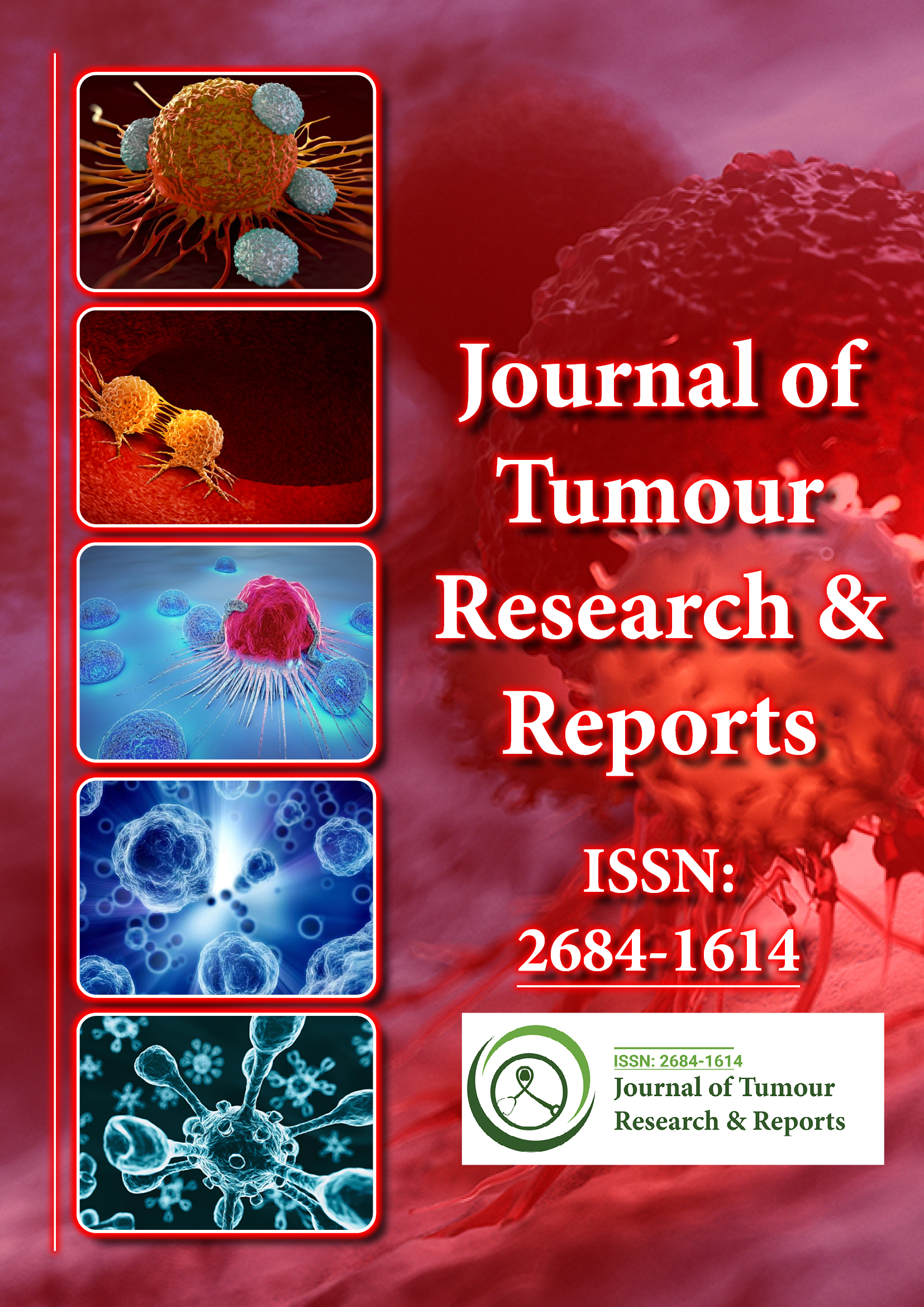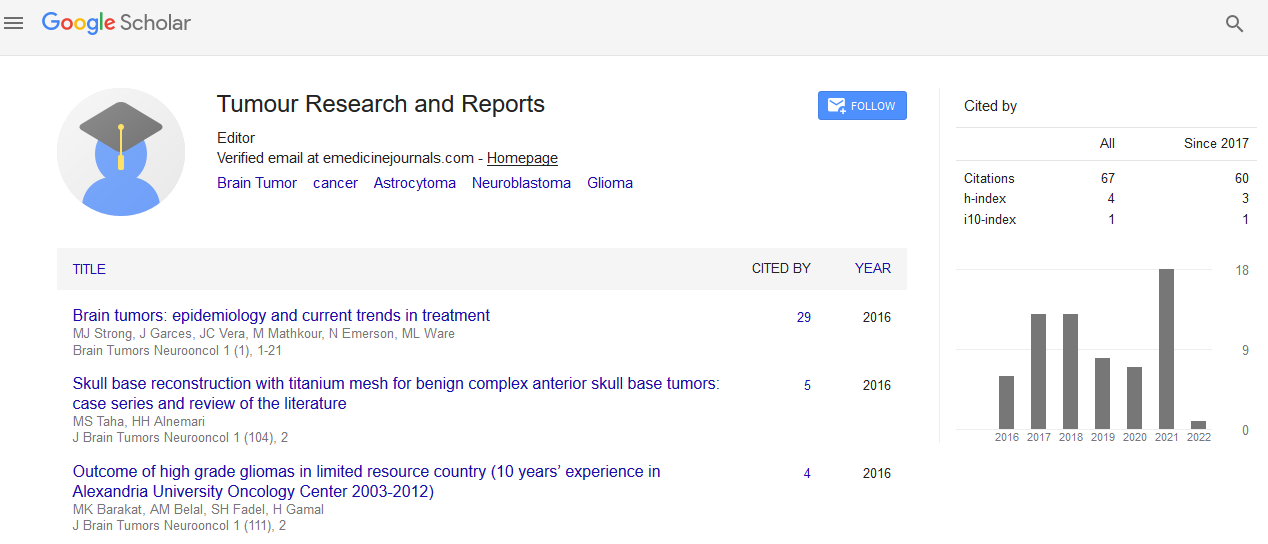Indexed In
- RefSeek
- Hamdard University
- EBSCO A-Z
- Google Scholar
Useful Links
Share This Page
Journal Flyer

Open Access Journals
- Agri and Aquaculture
- Biochemistry
- Bioinformatics & Systems Biology
- Business & Management
- Chemistry
- Clinical Sciences
- Engineering
- Food & Nutrition
- General Science
- Genetics & Molecular Biology
- Immunology & Microbiology
- Medical Sciences
- Neuroscience & Psychology
- Nursing & Health Care
- Pharmaceutical Sciences
Perspective - (2025) Volume 10, Issue 1
The Role of Hypoxia-Inducible Factors in Tumour Angiogenesis and Therapeutic Resistance
Claudia Herrmann*Received: 03-Mar-2025, Manuscript No. JTRR-25-29020; Editor assigned: 05-Mar-2025, Pre QC No. JTRR-25-29020 (PQ); Reviewed: 19-Mar-2025, QC No. JTRR-25-29020; Revised: 26-Mar-2025, Manuscript No. JTRR-25-29020 (R); Published: 02-Apr-2025, DOI: 10.35248/2684-1614.25.10.251
Description
Tumor progression is an intricate process influenced by genetic, metabolic, and environmental factors. One of the most significant micro-environmental features observed in solid tumors is hypoxia — a condition where the oxygen supply is insufficient to meet cellular demands. Hypoxia arises from rapid tumor cell proliferation outpacing the development of functional vasculature. This oxygen deficiency activates a transcriptional response primarily regulated by Hypoxia- Inducible Factors (HIFs), which orchestrate a complex network of genes involved in angiogenesis, metabolism, invasion, and resistance to therapy. Understanding the molecular underpinnings of HIF signaling is crucial for developing effective cancer therapeutics, particularly in combating tumor resistance mechanisms.
HIFs are heterodimeric transcription factors composed of an oxygen-sensitive alpha subunit (HIF-1α, HIF-2α , or HIF-3α) and a constitutively expressed beta subunit (HIF-1β). Under normoxic conditions, HIF-α subunits are hydroxylated by Prolyl Hydroxylase Domain Proteins (PHDs), targeting them for ubiquitination and proteasomal degradation via the Von Hippel- Lindau (VHL) E3 ubiquitin ligase. However, in hypoxic conditions, hydroxylation is inhibited, allowing HIF-α to accumulate, translocate to the nucleus, and activate transcription of target genes.
A major outcome of HIF activation is the induction of angiogenesis, primarily through the upregulation of Vascular Endothelial Growth Factor (VEGF). VEGF stimulates endothelial cell proliferation, migration, and new blood vessel formation, allowing tumors to adapt to hypoxic stress. Although this process temporarily alleviates hypoxia, the newly formed vasculature is often abnormal — leaky, disorganized, and inefficient — perpetuating a cycle of chronic hypoxia within the tumor microenvironment.
This hypoxia-driven angiogenesis has profound implications for cancer therapy. Firstly, abnormal vasculature impairs drug delivery, especially in the case of chemotherapeutics requiring uniform tissue perfusion. Secondly, hypoxia itself induces a state of cellular quiescence and metabolic adaptation that reduces susceptibility to DNA-damaging agents and radiation therapy. Radiotherapy, which relies on oxygen to generate free radicals that damage DNA, becomes significantly less effective under hypoxic conditions. Thirdly, hypoxia contributes to a stem cell-like phenotype in cancer cells, enhancing their capacity for self-renewal, invasion, and metastasis.
HIF-1α and HIF-2α also play distinct roles in tumor biology. HIF-1α is broadly expressed and primarily involved in the acute response to hypoxia, regulating genes related to glycolysis, angiogenesis, and pH regulation. In contrast, HIF-2α expression is more tissue-specific and associated with chronic hypoxia. HIF-2α regulates genes involved in proliferation, stemness, and immune evasion, often contributing to a more aggressive tumor phenotype. Interestingly, in some cancers like clear cell Renal Cell Carcinoma (ccRCC), HIF-2α rather than HIF-1α is the dominant oncogenic driver due to frequent VHL mutations.
Given the central role of HIFs in tumor adaptation, they represent attractive therapeutic targets. Several small-molecule HIF inhibitors have been developed, including those that directly bind and destabilize HIF-α subunits, inhibit dimerization, or block transcriptional activity. PT2385 and PT2977 (belzutifan) are selective HIF-2α inhibitors that have shown clinical efficacy in VHL-associated tumors and are under investigation in other solid malignancies. Additionally, targeting upstream regulators such as PHDs or downstream effectors like VEGF can modulate HIF activity indirectly.
Anti-angiogenic therapies, such as bevacizumab (an anti-VEGF monoclonal antibody), have been employed to starve tumors of blood supply. While initially effective, these agents often induce adaptive resistance, characterized by increased invasiveness and metastasis driven by residual hypoxic regions and compensatory pathways. Therefore, combination strategies that concurrently inhibit HIF signaling and angiogenic escape mechanisms are being explored to overcome resistance.
The interplay between HIFs and the immune system adds another layer of complexity. Hypoxia and HIF activity modulate the tumor immune microenvironment by upregulating immune checkpoint molecules like PD-L1, recruiting regulatory T cells (Tregs), and suppressing cytotoxic T-cell function. Consequently, combining HIF inhibitors with immune checkpoint blockade is a promising strategy that may potentiate anti-tumor immunity and improve responses in otherwise non-immunogenic tumors.
Furthermore, HIF signaling is involved in metabolic reprogramming — a hallmark of cancer. Hypoxia shifts cellular metabolism from oxidative phosphorylation to anaerobic glycolysis, facilitating survival in low-oxygen conditions. This metabolic switch not only supports rapid energy production but also promotes acidification of the tumor microenvironment, aiding invasion and immune escape. Inhibiting key glycolytic enzymes or targeting lactate transporters may synergize with HIF-targeted therapy to disrupt these adaptations.
Citation: Herrmann C (2025). The Role of Hypoxia-Inducible Factors in Tumour Angiogenesis and Therapeutic Resistance. J Tum Res Reports. 10:251.
Copyright: © 2025 Herrmann C. This is an open-access article distributed under the terms of the Creative Commons Attribution License, which permits unrestricted use, distribution, and reproduction in any medium, provided the original author and source are credited.

